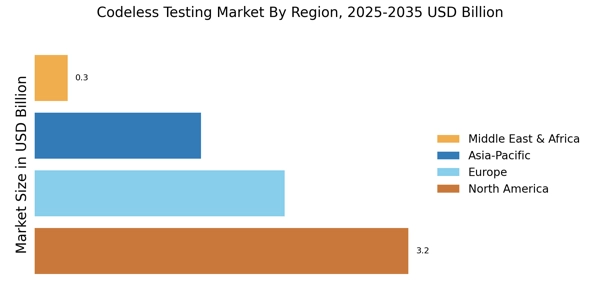Rise of No-Code Platforms
The emergence of no-code platforms has catalyzed the growth of the Codeless Testing Market. These platforms empower users, including those without extensive programming knowledge, to create and execute tests efficiently. As organizations increasingly prioritize speed and agility in software development, the demand for codeless testing solutions is likely to surge. According to recent estimates, the codeless testing segment is projected to grow at a compound annual growth rate of over 25% in the coming years. This trend indicates a shift towards democratizing testing processes, allowing a broader range of stakeholders to participate in quality assurance. Consequently, the Codeless Testing Market is poised to benefit from this democratization, as more businesses seek to streamline their testing efforts and enhance overall productivity.
Increased Focus on Quality Assurance
As software quality becomes increasingly critical, the Codeless Testing Market is witnessing a surge in demand for effective quality assurance solutions. Organizations are recognizing that robust testing processes are essential for delivering reliable software products. Codeless testing tools offer a streamlined approach to quality assurance, enabling teams to create and execute tests without extensive coding knowledge. This accessibility allows for broader participation in the testing process, fostering a culture of quality across teams. Market analysis indicates that companies investing in codeless testing solutions experience a notable improvement in defect detection rates, which can lead to enhanced customer satisfaction. The growing emphasis on quality assurance is likely to propel the Codeless Testing Market forward as businesses seek to elevate their software quality standards.
Growing Need for Faster Time-to-Market
In an era where speed is paramount, the Codeless Testing Market is experiencing heightened demand for solutions that facilitate faster time-to-market. Organizations are under pressure to deliver software products rapidly while maintaining high quality. Codeless testing tools enable teams to automate testing processes, significantly reducing the time required for test creation and execution. This efficiency is particularly crucial in competitive sectors where delays can result in lost opportunities. Market data suggests that companies utilizing codeless testing solutions can reduce their testing cycles by up to 50%, thereby accelerating their release schedules. As businesses strive to remain competitive, the Codeless Testing Market is likely to see continued growth driven by this urgent need for speed.
Integration with Continuous Testing Practices
The integration of codeless testing tools with continuous testing practices is reshaping the Codeless Testing Market. Continuous testing, a key component of DevOps, emphasizes the need for testing to occur at every stage of the software development lifecycle. Codeless testing solutions, which allow for rapid test creation and execution, align seamlessly with this approach. As organizations adopt DevOps methodologies, the demand for codeless testing tools that support continuous integration and delivery is expected to rise. This trend is reflected in market forecasts, which indicate that the codeless testing segment could capture a significant share of the overall testing market by 2026. The synergy between codeless testing and continuous testing practices is likely to drive innovation and efficiency within the Codeless Testing Market.
Adoption of AI and Machine Learning Technologies
The incorporation of artificial intelligence and machine learning technologies into codeless testing tools is transforming the Codeless Testing Market. These advanced technologies enhance the capabilities of codeless testing solutions, enabling them to adapt and learn from testing patterns. AI-driven codeless testing tools can automatically generate test cases, optimize testing processes, and even predict potential defects. This innovation is particularly appealing to organizations looking to improve efficiency and accuracy in their testing efforts. Market projections suggest that the integration of AI and machine learning in testing tools could lead to a substantial increase in market share for the codeless testing segment. As businesses increasingly recognize the potential of these technologies, the Codeless Testing Market is likely to experience significant growth.


















Leave a Comment